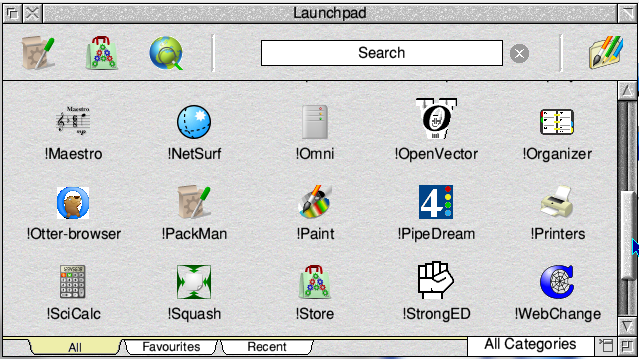Every RISC OS user should be familiar with the ‘Apps’ icon that appears on the left hand side of the icon bar. It first appeared with RISC OS 3, released in 1991, and was used to access and launch the bundled applications (such as Edit, Paint, and Draw) that were built into the RISC OS ROM for this version, rather than supplied on disc.
With subsequent versions of the operating system, those bundled applications didn’t always remain in ROM – sometimes they were in an ‘Apps’ folder on the hard disc – but the icon remained the standard way to launch them. Additional applications could also be added to Apps in one of two ways. They could be placed in the Apps folder, or they could be kept elsewhere, but the operating system told to include them in Apps through the use of the AddApps command.

There are other features of the Apps icon, but that aspect of it has been its predominant function since it was first introduced, over thirty years ago – and in all that time, it hasn’t changed much, if at all.
It’s a very limited system in the way it works. For example, there’s no easy way to categorise applications with in it, perhaps grouping them in sub-directories based on their primary function – so if all the applications used on a given computer are accessed via Apps, there can be an awful lot to look through to find the one you want.
This has no doubt been why a number of third parties have developed application launchers over the years, all offering their own way of improving on Apps.
We now have yet another, but this one is intended to be something more – Launchpad is a replacement for Apps, that offers a basic interface that works the same way (a directory window showing the applications available), but with a lot more bells and whistles.
Developed by Paolo Zaino, and released through the RISC OS Community, the new launcher is part of the Desktop Modernisation Engine – a project to make the RISC OS desktop look, feel, and behave like more modern desktops do on other platforms, while still retaining the ‘magic’ that makes RISC OS what it is.

Clicking on the icon with Select opens a window presenting your installed apps, and from which a double click will launch them, but with a number of additional features.
For example, there’s a separate strip at the top providing a number of tools, including a Search field, allowing you to search your apps for something specific. Simply typing a single letter will reduce the number of apps shown to those whose names contain that letter – and if the app you’re looking for isn’t there, an internet search is only a click away.
As well as finding applications by searching through their names, you can choose what categories they belong in, and you can view all those in a given category. The applications you launch most often are remembered, and can be found via the ‘Recent’ tab, and you can also tell Launchpad which applications are your favourites – and access them via the ‘Favourites’ tab.

Other useful features include the ability to hide the ‘pling’ (exclamation mark) from names, and to automatically open an application’s window when they are run. For RISC OS die-hards, both of these options are firmly off by default, but easily switched on.
In the case of the latter of the two, while having windows open automatically when an application is first run is arguably ‘not the RISC OS way‘tm, it can be useful for new users who may not realise that a new icon has appeared on the icon bar, and that having double clicked an application to run it, they now have to single click on that icon in order to do something with it.
Paolo has provided installation instructions for Launchpad over on the RISC OS Open forum. Please note that the software is currently considered an alpha release – it is still a very early development version, and shouldn’t be used on main systems. It is intended for people who want to try it out, find bugs, and make sure it works – and suggest ways in which it can be made better.

